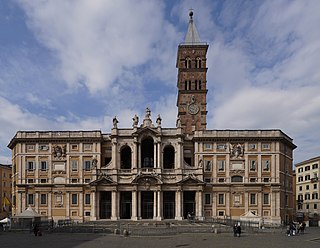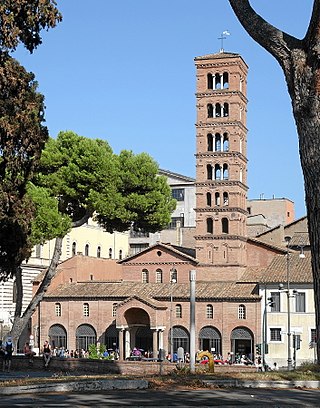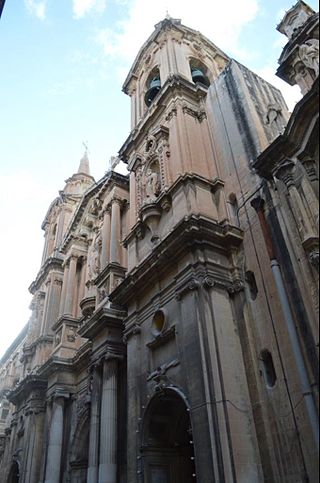
The Papal Basilica of Saint Paul Outside the Walls is one of Rome's four major papal basilicas, along with the basilicas of Saint John in the Lateran, Saint Peter's, and Saint Mary Major, as well as one of the Seven Pilgrim Churches of Rome.

The Basilica of Saint Mary Major, or church of Santa Maria Maggiore, is a Major papal basilica as well as one of the Seven Pilgrim Churches of Rome and the largest Catholic Marian church in Rome, Italy.
In the Catholic Church, a titular church is a church in Rome that is assigned to a member of the clergy who is created a cardinal. These are Catholic churches in the city, within the jurisdiction of the Diocese of Rome, that serve as honorary designations symbolising the relationship of cardinals to the pope, the bishop of Rome. According to the 1983 Code of Canon Law, a cardinal may assist his titular church through counsel or through patronage, although "he has no power of governance over it, and he should not for any reason interfere in matters concerning the administration of its good, or its discipline, or the service of the church".

The Basilica of Saint Mary in Cosmedin is a minor basilican church in Rome, Italy, dedicated to the Virgin Mary. It is located in the rione (neighborhood) of Ripa. Constructed first in the sixth century as a diaconia (deaconry) in an area of the city populated by Greek immigrants, it celebrated Eastern rites and currently serves the Melkite Greek Catholic community of Rome. The church was expanded in the eighth century and renovated in the twelfth century, when a campanile was added. A Baroque facade and interior refurbishment of 1718 were removed in 1894-99; the exterior was restored to twelfth-century form, while the architecture of the interior recalls the eighth century with twelfth-century furnishings. The narthex of the church contains the famous Bocca della Verità sculpture.

The church of San Carlo alle Quattro Fontane, also called San Carlino, is a Roman Catholic church in Rome, Italy. The church was designed by the architect Francesco Borromini and it was his first independent commission. It is an iconic masterpiece of Baroque architecture, built as part of a complex of monastic buildings on the Quirinal Hill for the Spanish Trinitarians, an order dedicated to the freeing of Christian slaves. He received the commission in 1634, under the patronage of Cardinal Francesco Barberini, whose palace was across the road. However, this financial backing did not last and subsequently the building project suffered various financial difficulties. It is one of at least three churches in Rome dedicated to San Carlo, including San Carlo ai Catinari and San Carlo al Corso.

Giacomo della Porta (1532–1602) was an Italian architect and sculptor, who worked on many important buildings in Rome, including St. Peter's Basilica. He was born at Porlezza, Lombardy and died in Rome.

As the home of the Pope and the Catholic curia, as well as the locus of many sites and relics of veneration related to apostles, saints and Christian martyrs, Rome had long been a destination for pilgrims. The Via Francigena was an ancient pilgrim route between England and Rome. It was customary to end the pilgrimage with a visit to the tombs of Saints Peter and Paul. Periodically, some were moved to travel to Rome for the spiritual benefits accrued during a Jubilee. These indulgences sometimes required a visit to a specific church or churches. Pilgrims need not visit each church.

There are more than 900 churches in Rome, which makes it the city with the largest number of churches in the world. Almost all of these are Catholic.

Santa Pudenziana is a church of Rome, a basilica built in the 4th century and dedicated to Saint Pudentiana, sister of Praxedes and daughter of Pudens. It is one of the national churches in Rome, associated with Filipinos.

The Minor Basilica of St. Mary in Domnica alla Navicella, or simply Santa Maria in Domnica or Santa Maria alla Navicella, is a Roman Catholic basilica in Rome, Italy, dedicated to the Blessed Virgin Mary and active in local charity according to its long tradition. It is one of the best examples of the so-called "Carolingian renaissance" in Rome. It has been the titular church of Cardinal Marcello Semeraro since 28 November 2020.

Tre Fontane Abbey, or the Abbey of Saints Vincent and Anastasius, is a Roman Catholic abbey in Rome, held by monks of the Cistercian Order of the Strict Observance, better known as Trappists. It is known for raising the lambs whose wool is used to weave the pallia of new metropolitan archbishops. The Pope blesses the lambs on the Feast of Saint Agnes on January 21. The wool is prepared, and he gives the pallia to the new archbishops on the Solemnity of Saints Peter and Paul, the Holy Apostles.

Sant'Agata dei Goti is a church in Rome, Italy, dedicated to the martyr Agatha of Sicily. It is the diaconia assigned to Cardinal Raymond Leo Burke, patron emeritus of the Sovereign Military Order of Malta.

Santa Maria in Campitelli or Santa Maria in Portico is a church dedicated to the Virgin Mary on the narrow Piazza di Campitelli in Rione Sant'Angelo, Rome, Italy. The church is served by the Clerics Regular of the Mother of God.

Santa Maria Scala Coeli is a Roman Catholic Church located on the grounds of the Tre Fontane Abbey located on Via di Acque Salvie 1 in the Quartiere Ardeatino in Rome. This is one of three churches affiliated with the Trappist monastery, and is located on a small lane, Via delle Tre Fontane, inside the abbey complex. The location of this church is held by tradition to be where St Paul the Apostle was imprisoned. on Via delle Tre Fontane in Rome.

Jacopo Torriti or Turriti was an Italian painter and mosaic maker who lived in the 13th century.
A diaconia was originally an establishment built near a church building, for the care of the poor and distribution of the church's charity in medieval Rome or Naples. Examples included the sites of San Vito, Santi Alessio e Bonifacio, and Sant'Agatha in Rome, San Gennaro in Naples (headed by a deacon named John in the end of the ninth and the beginning of the tenth century. The popes allocated to the Romans bathing through diaconia, or private Lateran baths, or even a myriad of monastic bath houses functioning in eighth and ninth centuries.

The Collegiate Parish Church of St Paul's Shipwreck, also known as simply the Church of St Paul's Shipwreck, is a Roman Catholic parish church in Valletta, Malta. It is one of Valletta's oldest churches.

Mauro Piacenza JCD is an Italian prelate of the Catholic Church. A cardinal since 2010, he has served as Penitentiary Major of the Apostolic Penitentiary since his appointment by Pope Francis on 21 September 2013. He was Prefect of the Congregation for the Clergy from 7 October 2010 to 21 September 2013. where he had been Secretary since 2007. At that Congregation, Pope Benedict XVI, according to one report, valued "his efficiency and in-depth knowledge of how the Congregation worked and its problems" and "his traditionalist ecclesiastical line of thought".

The Basilica of Saints John and Paul on the Caelian Hill is an ancient basilica church in Rome, located on the Caelian Hill. It was originally built in 398.

The Stefaneschi Altarpiece is a triptych by the Italian painter Giotto, from c. 1320. It was commissioned by Cardinal Giacomo Gaetani Stefaneschi to serve as an altarpiece for one of the altars of Old St. Peter's Basilica in Rome. It is now at the Pinacoteca Vaticana, in Rome.




















